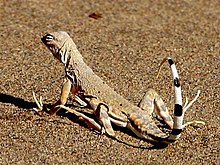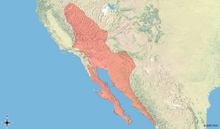Zebra-tailed lizard
| Callisaurus draconoides | |
|---|---|
 |
|
| A zebra-tailed lizard | |
| Scientific classification | |
| Kingdom: | Animalia |
| Phylum: | Chordata |
| Class: | Reptilia |
| Order: | Squamata |
| Suborder: | Iguania |
| Family: | Phrynosomatidae |
| Genus: |
Callisaurus Blainville, 1835 |
| Species: | C. draconoides |
| Binomial name | |
|
Callisaurus draconoides Blainville, 1835 |
|
 |
|
Zebra-tailed lizards (Callisaurus) are a genus of phrynosomatid lizards endemic to the southwestern United States and northwestern Mexico.
They live in open desert with fairly hard-packed soil, scattered vegetation and scattered rocks, typically flats, washes and plains.
They range in size from 2.5 to 4 inches (64 to 102 mm) in snout-to-vent length. These lizards are grey to sandy brown, usually with series of paired dark gray spots down their backs, becoming black bands on the tails. The underside of tail is white with black bands. Males have a pair of black blotches on their sides, extending to blue patches on their bellies. Females have no blue patches, and the black bars are either faint or completely absent.
They are diurnal and alert. They rise early and are active in all but the hottest weather. During the hottest times of day, lizards may stand alternately on two legs, switching to the opposite two as needed in a kind of dance. When threatened they will run swiftly with their toes curled up and tails raised over their backs exposing the stripes. When stopped, they wag their curled tails side-to-side to distract predators. They can even run on their hind legs for short distances. In areas of creosote scrub this lizard seems to reach highest densities, around 4.8 to 6.0 individuals per acre (600 to 800 m² per lizard). This lizard burrows into fine sand for retreat at night and usually seeks day shelter in the shade of bushes. They are also known to burrow under sand for safety when being chased by predators.
In summer, 2 to 8 eggs are typically laid, hatching anywhere from July to November. However, more than 1 clutch can be laid during a season. Eggs are laid, presumably, in friable, sandy soil. Being a prey species for many animals, including birds, other lizards, and mammals, they have a fairly high reproductive rate.
...
Wikipedia
